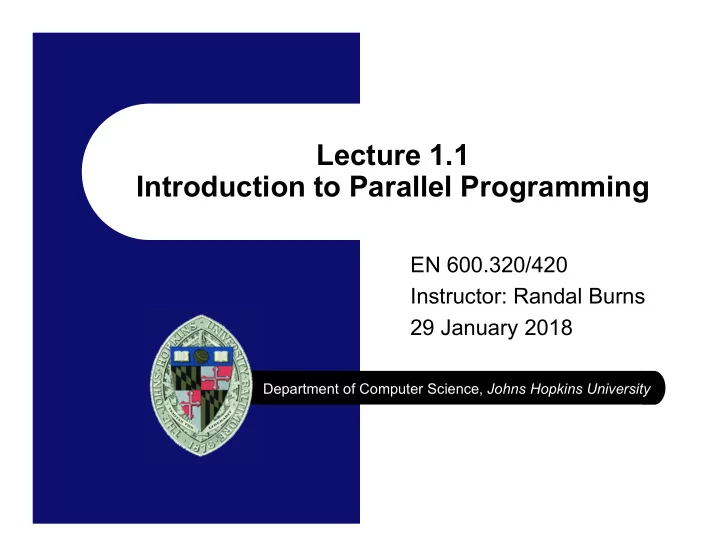

Lecture 1.1 Introduction to Parallel Programming EN 600.320/420 Instructor: Randal Burns 29 January 2018 Department of Computer Science, Johns Hopkins University
Why this class? Parallelism is everywhere! Every program/programmer needs to address it – Traditional CS curriculum totally misses the point Who should take it? Anyone who needs to program ever. Period! Exclamation point!! … Designed for Sophomores: quick lift of skills good for employers and internships Lecture 1: Introduction to Parallel Programming
What ’ s a computer look like? http://www.cis.upenn.edu/~dietzd/CIT596/turingMachine.gif Lecture 1: Introduction to Parallel Programming
Notions of a Computer Sequential processing Control or logic flow – Algorithm costs measured in this model Big-O notation counts number of sequential steps – This is the basis for the CS curriculum And it ’ s just wrong – Computers are not sequential and performance is more nuanced than – counting the number of steps I demand a new curriculum That treats computers as parallel entities, programs concurrency and – parallelism, and makes the world a better place Lecture 1: Introduction to Parallel Programming
Wrong you say? Realities of computing We have tons of wasted cycles – CPU utilization typically <10% (of useful work) – Many other things limit performance Pipeline stalls – Lock interference – Waiting for I/O and network – Data dependencies – Writing serial programs is broken Parallelism is everywhere – Must exploit it to realize time efficiency, power savings – Lecture 1: Introduction to Parallel Programming
Lecture 1: Introduction to Parallel Programming
Multi-Core Independent processing units on one chip Lecture 1: Introduction to Parallel Programming
What ’ s a Parallel Computer? Lecture 1: Introduction to Parallel Programming
What ’ s a Parallel Computer? Lecture 1: Introduction to Parallel Programming
What ’ s a Parallel Computer? Lecture 1: Introduction to Parallel Programming
What ’ s a Parallel Computer? Lecture 1: Introduction to Parallel Programming
What ’ s a Parallel Computer? Lecture 1: Introduction to Parallel Programming
What ’ s a Parallel Computer? Lecture 1: Introduction to Parallel Programming
Whats a Parallel Computer? Lecture 1: Introduction to Parallel Programming
Whats a Parallel Computer? Lecture 1: Introduction to Parallel Programming
Conclusions Every computer is a parallel computer Parallel computers need independent work to run their many cores (or other resources) efficiently Themes of this class: Identify available parallelism in programming tasks – Encode parallelism in parallel programs – Understand parallel hardware and how to optimize parallel – performance Lecture 1: Introduction to Parallel Programming
Recommend
More recommend